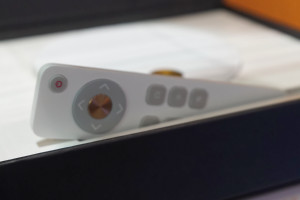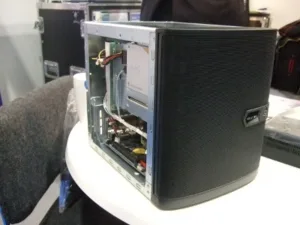 Arris’s new remote looks attractive – and Ruwido was on the firm’s booth, so….Access was showing its latest developments. Access makes components (such as a browser) that are integrated into middleware. The company’s added value often comes from careful optimisation of software and hardware acceleration. The latest developments is in the area of metadata and analysis, helping service providers to better work out what to sell to their customers with better prediction allowing more accurate upsell targetting.
Arris’s new remote looks attractive – and Ruwido was on the firm’s booth, so….Access was showing its latest developments. Access makes components (such as a browser) that are integrated into middleware. The company’s added value often comes from careful optimisation of software and hardware acceleration. The latest developments is in the area of metadata and analysis, helping service providers to better work out what to sell to their customers with better prediction allowing more accurate upsell targetting.
Arris would like to have talked more, but we met the company just before the completion of its deal to set up a JV with Charter for Advanced Video Networks, and of course, Pace, which it is hoping to acquire, is a competitor for the moment. The company did show us some of its new STB designs. What was the Motorola STB business is now being run from Sweden and one of the aims is to bring European industrial design values to make the products look more attractive.
DCC Labs was departing from what it calls ‘the traditional industry approach of taking a pre-existing middleware product and shoehorning it into the individual operator’s requirements’. Instead it showed a new service called Freestyle, which builds a hybrid client ‘from the ground up’. Freestyle uses open stack components based on HTML5 and QML. It is designed to deliver interactive and traditional broadcast services, on both new and legacy hardware – including STBs, smartphones and smart TVs.
Gigabyte is best-known for its PC gaming products. It was at TV Connect to promote its servers. Server Case was representing the company, and was showing the PowerNAS, a three-in-one device: Windows 8.1 PC, gateway and NAS. Owners can fit up to 24TB of storage in the (fairly compact) unit, as well as an optical disc drive.
NeuLion took over DivX from Rovi (as well as the codec technology company, Main Concept) and is integrating the technology into its services for providing OTT streams for live events (mainly) and VOD. The company ran around 150 events per day last year and provides a complete service of capture, editing (including the real-time addition of metadata and statistics – popular with sports) and storage, right down to payment processing. It has its own CMS and the firm’s playback technology allows trick play such as rewinding and speed changes. DivX will continue to work with set makers to support live and recorded media playback.
Nexguard held a panel on 29th (the day after I attended; very frustrating – TA), talking about forensic watermarking, to protect content from illegal redistribution. Senior director Pascal Marie discussed the growth in technologies, such as free smart TV apps and inexpensive OTT boxes, that enable high-quality content copies. Using forensic watermarking, operators can trace content to its original source. The company also talked about its new session-based STB and OTT watermarking, supplemented by on-the-fly watermarking detection and web monitoring; this combination is designed to protect operators and prevent illegal redistribution.
Sigma Designs had a meeting room and told us that it has now added Dolby Vision support for its STB chips – we reported on support on its TV chips earlier. It was also promoting its HEVC solutions that cover FullHD at the low end, UltraHD at 30P in the mid-range and full UltraHD at 60P at the high end.
Skyworth had a small stand, promoting its own middleware and existing HbbTV STBs.
TV Connect 2015 was TCL‘s first time at a broadcast show in Europe. We are more familiar with the company’s hardware side, as are most in the West. The company launched its OTT services in China two years ago, and now claims to be bigger in the space than any competitor. The ‘TV+’ movement announced at CES (TCL Transitions From Manufacture to Entertainment) is ‘Products + Services’. TCL is now working to raise the profile of its OTT services outside of China and wants to be a significant OTT operator worldwide.

